Next Page Previous Page Home Page Fixtures, Results & Events Games Page Quote, Unquote
Chess Study
![]() "Long, long ago, before Steinitz, it was
considered that a chessplayer wins or loses a game solely by virtue of his
ingenuity. Morphy was a genius, and so beat he beat everyone; his opponents were
less talented, and therefore they lost to him. Steinitz recognised and
demonstrated that chess has an objective basis. The events which occur on the
board are subject to certain laws, to positional principles. If a chess player is
guided by them then he will be successful."
"Long, long ago, before Steinitz, it was
considered that a chessplayer wins or loses a game solely by virtue of his
ingenuity. Morphy was a genius, and so beat he beat everyone; his opponents were
less talented, and therefore they lost to him. Steinitz recognised and
demonstrated that chess has an objective basis. The events which occur on the
board are subject to certain laws, to positional principles. If a chess player is
guided by them then he will be successful."
Mark Dvoretsky, Training for the Tournament Player.
Many chess players have erected their understanding of the game on rotten foundations. The years go by they enjoy some success and pick up some knowledge of a number openings. Eventually they soon discover that against opponents of a particular strength they can do nothing - they just lose over and over again. A kind of plateau is reached beyond which it just seems impossible to progress. Their grasp (and I don't exclude myself from this!) of the game is slipshod and incomplete. The game is not thought of in terms of a homogeneous whole but as a series of disjointed fragments. We have all heard of the expression "practice makes perfect". Where chess is concerned I'm not so sure. I think the truth is that most club players become skilled in their mediocrity - it becomes something they hone to perfection! I know that I have done an awful lot of honing over the years!
BEGINNERS
I would like to add a few of my own to the above list [some of which I find personally rather unadventurous]
For a start: How to Reassess Your Chess by IM Jeremy Silman. A really wonderful piece of work in my opinion. Does something that sadly many chess books don't do: makes you think about the game in a different way - at least that was the effect on me. There is some truly original thinking in this book. I don't know whether it is still in print. My own copy is published by Thinker's Press of Davenport, IA.
Silman reviews books for Inside Chess Magazine and very engaging and readable they are too. To go there click on Silman's Reviews.
Training For the Tournament Player by Mark Dvoretsky. Has a fantastic reputation. Dvoretsky is reputed to be the world's foremost chess coach. This book is fairly advanced [but not too much]. Again, distinctively written and thought provoking. Contains lots of exercises; published by Batsford. Another book by Dvoretsky is Secrets of Chess Training, with a foreword by Kasparov, also published by Batsford. Be warned! This is somewhat difficult - heavy and challenging. Will not suit everyone.
Practical Endgame Lessons by Edmar Mednis. An interesting book on endings. Published by Batsford. Again, I'm not sure whether it's still in print. My own edition is twenty years old and in English descriptive. Highly readable.
Some years ago (many years ago!) I remember borrowing some books from the public library in Ipswich. They were: My Early Years, My Middle Years, and My Later Years. I'm not completely certain about these titles. Anyway, they were the selected games of Paul Keres and annotated by him. And what annotations; absolutely wonderful! He was just brilliant at explaining the thinking behind his moves. I haven't seen these books in years and I suspect they are now out of print. But in the last four years or so they may have been reprinted in a single volume. I say may because I'm not sure. There is The Road To The Top by Paul Keres. I haven't personally seen this. Is this a reprint in a single volume of the three earlier books? It may be. Even if it isn't, anything by Keres is worth having!
Update: The above is partially correct. I have since discovered that The American Batsford Library (the U.S. counterpart of Batsford Publishing in England), has re-issued the series in a two-volume set, with some editing and additional material added by GM John Nunn. The first volume is entitled Paul Keres: The Road to the Top and deals with Keres' career until 1950. There are fifty-one annotated games by Keres, with additions, corrections and comments, all given in the form of footnotes, added by Nunn. The second volume is entitled Paul Keres: The Quest for Perfection and concerns itself with the balance of Keres' career, presenting fifty-two annotated games. The original series presented games through 1962. Nunn has added five games to this part of the book, drawing from the original Russian edition that contained them (the English edition, apparently, didn't). Nunn has also added another fifteen games himself to complete the series. The result is a terrific presentation of the games and career of a great, much missed world-class grandmaster. While never quite losing his taste for the attacking style of his youth, as he grew older, his play became more strategically based. This two-volume series covers his best over a 45-year playing career against some of the world's strongest players.
From the first volume here is:
Stahlberg - Keres, Bad Nauheim 1936. Nimzo-Indian Defense 1. d4 e6 2. c4 Bb4+ 3. Nf3 c5 4.e3 Nf6 5.a3 Bxc3+ 6. bxc3 0-0 7.Bd3 d5. 8.cxd5 exd5 9.Ne2 g6 10. 0-0 Ba6 11.Bc2? Nc6 12.Rel Re8 13. f3 Rc8 14. dxc5? bxc5 15. Ng3 d4! 16.exd4 cxd4 17.Rxe8+ Qxe8 18.cxd4 Nxd4 19.Ba4 Qe5 20.Rbl Nd5! 21.Bb2 Nc3 22.Bxc3 Rxc3 23.Khl h5! 24.Bd7 Rd3 25.Qa4 Bb7

26 Ne4? Bxe4 27.fxe4 Nf3! 0-1 Either 28.gf3 or 28.g3 can be answered by 28...Rd2. These marvelous games as well Keres' fascinating career make great reading. They have both been overlooked for too long. For copyright reasons I haven't been able to include Keres' wonderful notes. This is rather like having a Sunday roast without any gravy! For those you will just have to buy the books! Fred Reinfeld, incidentally, has covered part of the same ground in his book, Keres' Best Games of Chess 1931-1948 published by Dover. Worth looking at but hardly the voice of the master.
******************************************************************
 Endgame Study by Reti
Solution:
The key point to notice is that Black is threatening to play Be5 and Rh8++. This
rules out any Queen moves (Black would just play ...Be5) So White must
move his King - and that means 1.Kh6. [The Queen sac 1.Kg7 doesn't work
due to 1...Be5 2.c4 Bf6+ 3.gf6 b4! White is now in zugswang, since 4.Kh7
frees Black's King - 4...Kd7]. After 1.Kh6 you might think that White is
going to try and place his King on square h5 to free his Queen. So 1...Be5.
But now 2.Kg7! Fantastic! The Queen sac works now because it's
Black's move; now it's he
who is in zugswang. He cannot play take the Queen, since after 2...Bf6+ 3.gf6
White will win the Rook with a won pawn ending. So, 2...Bh2 3.c4 bc4. Not
3...b4 4.c5 of course. 4.e5! Be5. If 4...d5 or 4...de5 5.Qc6+. 5.bc4 Bf6+.
Now the Queen has to be taken, since 5...Bh2 6.c5 Be5
7.cd6. 6.gf6 Rh8 7.Kh8 Kd7 8.Kg8! Ke6 9.Kg7, winning the f-pawn.
Wonderful stuff! It's a work of art. Who needs to go to the Tate Modern when you
can play through this for nothing! The King's side -step: 1.Kh6 and only then
2.Kg7! is quite brilliant. One's 'chess imagination' has to be quite acute to
see that.
Endgame Study by Reti
Solution:
The key point to notice is that Black is threatening to play Be5 and Rh8++. This
rules out any Queen moves (Black would just play ...Be5) So White must
move his King - and that means 1.Kh6. [The Queen sac 1.Kg7 doesn't work
due to 1...Be5 2.c4 Bf6+ 3.gf6 b4! White is now in zugswang, since 4.Kh7
frees Black's King - 4...Kd7]. After 1.Kh6 you might think that White is
going to try and place his King on square h5 to free his Queen. So 1...Be5.
But now 2.Kg7! Fantastic! The Queen sac works now because it's
Black's move; now it's he
who is in zugswang. He cannot play take the Queen, since after 2...Bf6+ 3.gf6
White will win the Rook with a won pawn ending. So, 2...Bh2 3.c4 bc4. Not
3...b4 4.c5 of course. 4.e5! Be5. If 4...d5 or 4...de5 5.Qc6+. 5.bc4 Bf6+.
Now the Queen has to be taken, since 5...Bh2 6.c5 Be5
7.cd6. 6.gf6 Rh8 7.Kh8 Kd7 8.Kg8! Ke6 9.Kg7, winning the f-pawn.
Wonderful stuff! It's a work of art. Who needs to go to the Tate Modern when you
can play through this for nothing! The King's side -step: 1.Kh6 and only then
2.Kg7! is quite brilliant. One's 'chess imagination' has to be quite acute to
see that.If you want to see more studies like the one above I've just started to collect some.
Go to the Endgame Studies Page.
French Milner-Barry.
Thomas Feeney - Kiven Plesset
1.e4 e6 2.d4 d5 3.e5 The normal line is, of course, 3.Nc3. For this line go to my game against Goodchild on the Members page [3...Bb5 4.e5 c5 5.Bd2?! Suffolk League 2001] 3...c5 4.c3 In this variation White seeks to give additional support to point d4. The pawn chain now extends from b2 to e5. 4...Nc6 5.Nf3 Qb6 6.Bd3 cxd4 7.cxd4 Bd7 Of course white's d-pawn is, in effect protected twice: 7...Nd4? 8.Nd4 Qd4 9.Bb5+. 8.O-O White decides to sac his d-pawn for quick development. 8...Nxd4 9.Nxd4 Qxd4. 10.Nc3?! Very sharp. White offers another pawn. 10...a6. Black declines. After 10...Qe4 he has a two pawn advantage but is dangerously behind in development. Even so how does White proceed? One idea is to attack the Queen by 11.Re1 and so make possible tactics based on Black's pinned e-pawn: 11...Qc7 12.Nd5; 11...Qd4 12.Nb5 Qb6 13.Be3 and it's clear that Black's position is rather uncomfortable. The idea of 10...a6 is stop a piece landing on b5. So, let's see what happens. 11.Qe2 Ne7! 11...Rc8 is the main line recommended by theory. The line continues 12.Kh1 Bc5 13.Bg5 h6 14.Bd2 Ne7 15.Rac1 Qh4! 16.f4 Nf5 17.Bxf5 exf5 18.b4! Ba7 (18...Bxb4?! 19. Nxd5) 19.Nxd5 O-O with approximately equal chances. However, what about 15.f4!? (instead of 15.Rac1) 15...O-O 16.Rf3 Bb6? (Loses a piece. Mandatory was 16...Nf5, but after 17.Rd1!? Black faces big problems.) 17.Be3 Qb4 18. a3 Qb3 19.Bc2! 1-0, P. Djuric--Jovicevic, Yugoslavia 1994. According to Uhlmann, the move played in this game (11... Ne7) is the best continuation for Black. 12.Kh1 Qh4!?
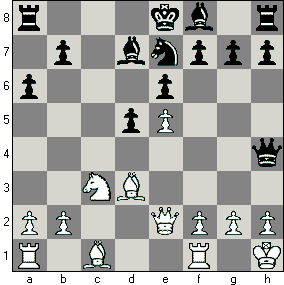
Uhlmann gives 12...Nc6 13.f4 Bc5! attempting to take advantage of White's weakened dark squares with chances for both sides. 13.f4 g6 14.Be3?! Perhaps 14.Bd2 was better. My feeling here is that unless White comes with 'something big' he's just going to be a pawn down for nothing. 14...Nf5 15.Bxf5? I know from personal experience how annoying the Black knights can be and how tempting it is to get rid of them but this doesn't look at all convincing. 15...gxf5 16.Rf3 Rg8. Setting a tactical trap. Black could also consider the sacrifice of a pawn to activate his light-squared Bishop (you can find a similar idea in the notes to my game against Goodchild on the Members Page): 16... d4!? 17.Bxd4 Rg8, intending 18...Bc6, or if 17.Rh3 Qg4 18.Bxd4 Qxf4. 17.Rh3? Obligingly White falls right in!

17...Qxh3! The opening of the g-file and the a8-h1 diagonal is fatal for White. 18.gxh3 d4! 0-1 The only defense against the deadly check from c6 is 19.Rf1 Bc6+ 20.Rf3 dxe3 21.Nd1 (21.Qxe3 Bc5!), Black wins by 21...Bc5 22.Nxe3 Bxe3 23.Qxe3 Rd8 24.Qe2 Rd2 25.Qf1 Rxb2, followed by 26... Rb1 or by 26...Bxf3+ 27.Qxf3 Rb1+. Neat!
![]()
![]()
![]()
![]()
![]()
![]()
![]()
![]()
![]()
![]()
![]()
![]()
Nimzo-Indian
Samisch
GM Utut Adianto - John Eid
1.d4 Nf6 2.c4 e6 3.Nc3 Bb4 4.f3 d5 5.a3 Bxc3+ 6.bxc3 O-O 7.e3 b6 8. cxd5 exd5 9.Bd3 Re8 10.Ne2 Bb7?! Uhm. What is the best square for this piece? From b7 Black attempts to curtail the advance of White's pawns in the center. The alternative (probably better) is to position the piece on square a6 and try to exchange off it's threatening opposite number on d3. 11.O-O Nc6? Too slow! I think Black has to react quickly now before White assumes a dangerous initiative. 12.Ng3 Ne7 13.e4 dxe4 14.fxe4 c5 At last but much less effective now than it would have been on move 11. 15.e5 Nfd5
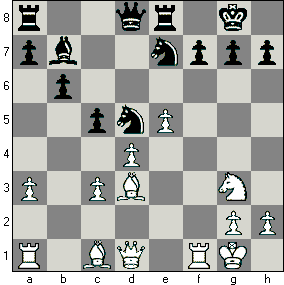
16.Bxh7+ Taking advantage of the lack of a defensive Knight on f6. But just look at Black's King-side; his King has no piece cover - no Knight on f6, the Rook has moved from f8 to e8. White, on the other hand, has an overwhelming advantage on that side of the board: Knight, Rook, both Bishops and his Queen are able to move into that sector very quickly; if Black had time to play his Knight to g6 (and maybe his other Knight to f8) he might be able to hold the position but he isn't given the chance. You see how dangerous White's light-squared Bishop on d3 can be? The imbalance between this bishop and it's opposite number on b7 is striking. It just confirms my suspicion that in this variation when White plays f3, Ng3 and e4 Black should seriously consider ...Ba6 rather than ...Bb7. 16...Kxh7 17.Qh5+ Kg8 18. Qxf7+ Kh7 19.Nh5 Rg8 20.Nf6+ Nxf6 21.Rxf6 Rf8 22.Rh6 mate
![]()
![]()
![]()
![]()
![]()
![]()
![]()
![]()
![]()
![]()
![]()
![]()
Click here for the top of the page.
Queen's Gambit
Declined
GM John Fedorowicz - Jason Luchan
1.d4 Nf6 2.Nf3 e6 3.c4 d5 4.Nc3 Be7 5.Qc2!? A new idea. White's idea is simple: play e2-e4 and open the centre. 5...O-O. Theory says this move leads to equality - uhmm! Instead, 5...c5 is the usual reaction against Qc2 in the Queen's Gambit, but, after 6.dxc5 Na6 7.Bg5 Qa5 8.e3 Nxc5 9. Nd2! dxc4 10.Nxc4 or 10.Bxc4 O-O 11.Bf4!, White retains slightly better chances. 6.e4 dxe4 7.Nxe4 b6?! 6...Nbd7 is more solid; retaining the option of taking on f6 with the Knight. 8.Nxf6+ Bxf6 9.Bd3 h6 10.Bh7+! Interesting. What's the point of it? We'll see. 10...Kh8 11.Be4 c6 12.Be3 Bb7 13.Qd2 Nd7 14.O-O-O Qc7 There is no defense against the coming sac on h6, e.g., 14...Re8 15.Bxh6 gxh6 16.Qxh6+ Kg8 17.Bh7+ Kh8 18.Bg6+ Kg8 19.Qh7+ Kf8 20.Qxf7 mate. I take it that this was the idea behind 10.Bh7+! The Queen lands on h6 with check and after 14...Re8 point f7 is undefended. 15.Bxh6 Be7 16.Bf4 Bd6 17.Bxd6 Qxd6 18.Qg5 Nf6 19.Qh4+ Kg8 20.Ng5 Rfe8
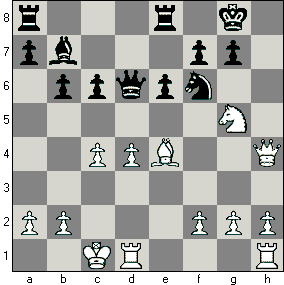
21.Qh8+! 1-0
For if 21...Kxh8 22.Nxf7+ Kg8 23. Nxd6, etc. Actually, there is something rather familiar about 21.Qh8+. The same idea occurred in one of the Spassky-Petrosian games from the World Championship match of 1966 (I can't remember which game and it could have been the 1969 match. Well! It was a long time ago)!!
![]()
![]()
![]()
![]()
![]()
![]()
![]()
![]()
![]()
![]()
![]()
![]()
English
Hal Terrie - GM Alex Yermolinsky
1.c4 g6 2.Nc3 Bg7 3.Nf3 c5 4.g3 Nc6 5.Bg2 d6 6.O-O e5 7.Ne1 White re-groups. The Knight can go to square c2 and then, depending on what Black does, maybe e3. 7...Be6 8.d3 Nge7 9.Nc2 d5 10.cxd5 Nxd5 11.Bd2?! I don't like it. Better, I suspect, is 11.Ne4 b6 12.Ng5 Bc8 13.Ne3! When White's Knight's work rather nicely. 11...O-O 12.Nxd5 Bxd5 13.Bc3 Bxg2 14.Kxg2 Qd7 15.b4 This activity turns out to be in Black's favour. 15...cxb4 16.Nxb4 a5! The point. If 17.Nxc6? Qxc6+ and 18... Qxc3. 17.Nc2 b5 Firmly taking the initiative. 18.a3 The tactics work to Black's advantage. If 18.Rb1 or 18.Rc1 18...Qd5+ and 19...Qxa2. 18...Rfc8 19.Qd2? Overlooking Black's reply. 19...Ne7!
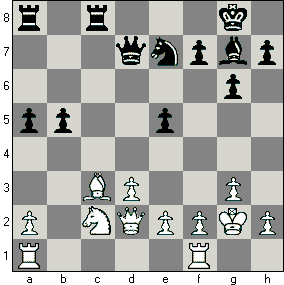
0-1 Looks surprising doesn't it? But White cannot avoid losing a piece on the c-file. If 20.Ne3 or 20.Bb2 Qc6+ and 21...Qxc3 or 21... Qxc2, and if 20.Kg1 Qc6. Really White was struggling after his ill conceived thrust 15.b4.
![]()
![]()
![]()
![]()
![]()
![]()
![]()
![]()
![]()
![]()
![]()
![]()
Pirc
GM Andres Rodriguez - Daniel Gordon
1.e4 d6 2.d4 g6 3.h4!? Nf6 4.Nc3 Bg7 5.Be2 h5?! Committal because it places the g5-square at White's disposal. Theory recommends immediate counter-play in the center by 5...Nc6. 6.Nf3 c6 7.Ng5 Nbd7?? An instructive mistake. Black loses by force! He had to play either 7...O-O or 7...Qc7.
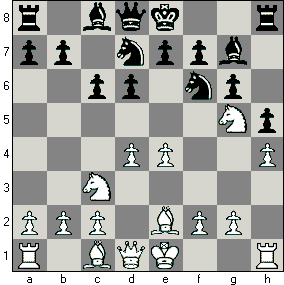
8.e5! dxe5 9.dxe5 Nd5 If 9...Nxe5 10.Qxd8+ Kxd8 11.f4 and Black loses an Exchange. 10.Nxd5 cxd5 11.e6 Ne5 12.f4 f6 13. fxe5 fxg5 14.Bb5+ Kf8 15.Qf3+ Bf6 16.exf6 Qa5+ 17.Bd2 Qxb5 18.fxe7+ Kxe7 19.Bxg5+ Kd6 20.Qa3+! Kxe6 If 20...Qc5 21.Be7+, or 20...Kc6 21.Qc3+ and 22.Qxh8. 21.Qe7+ Kf5 22.Qf6+ 1-0
The loser of the previous game wins the next game, which is also extremely interesting for the theory of the Staunton Gambit.
![]()
![]()
![]()
![]()
![]()
![]()
![]()
![]()
![]()
![]()
![]()
![]()
Dutch Staunton Gambit.
Dragol Milicevic - Daniel Gordon
1.d4 f5 2.e4 fxe4 3.Nc3 Nf6 4.Bg5 Nc6 5.d5 Ne5 6.Qd4 Nf7 7.Bxf6 gxf6 8.Qxe4
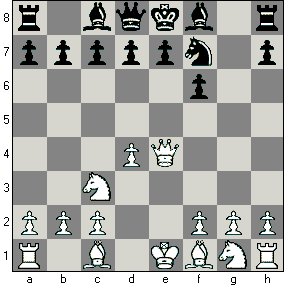
Mentioning 7...gxf6 only as a move which deserves attention, ECO's latest edition finishes the variation with 8. Qxe4!?, unclear. Amen to that!! I thought it was only us British who possessed a talent for understatement! Black' position looks a mess and so it proves! 8...Bh6 9.f4 c6 10.Bd3 Qb6 11. O-O-O Nd6 12.Qf3 O-O 13.Nge2 f5 14.g4 e6 15.gxf5 exd5 Now White's attack is irresistible. Maybe 15...Nxf5 offers some defensive chances. 16.Rhg1+ Kh8 17.Qh5 Rf6 18. Rg3 Qd8 19.Rdg1 Qf8 20.Qg4 Bg7 21.Qxg7+ Qxg7 22.Rxg7 h5 23.Rg8+ Kh7 24.R1g7+ Kh6 25.Rg6+ Rxg6 26.Rxg6+ 1-0
Sicilian Najdorf
Reynaldo Del Pilar - George Trammell
1.e4 c5 2.Nf3 d6 3.d4 cxd4 4.Nxd4 Nf6 5.Nc3 a6 6.f4 e5 7.Nf3 Nbd7 8.a4 b6 9.Bc4 Bb7? Black should play 9...Be7. 10.Ng5 d5 11.Nxd5 Bc5

Now White can't castle King-side and Black's bishops look menacing. Hard to believe the game lasts just six more moves! 12.Nxf7! Not so clear is 12.Nxf6+ Qxf6 13. Bxf7+ Ke7 or 13.Nxf7 exf4. 12...Kxf7 13.Nxf6+ Kxf6 14.fxe5+ Ke7 15.Bg5+ Nf6 16.exf6+ gxf6 17. Bxf6+! Kxf6 18.Rf1+ 1-0 For if 18...Kg5 19.h4+ Kh6 20. Qc1+ Kg6 (20...Kg7 21.Rf7+ Kg6 22.Qf4) 21.h5+ Kxh5 22.Rf5+ Kg6 23.Qf4 and wins.
Click here if you want to look at the Problem Page
Although I've tried my best to eliminate any errors on this page if you find any I would appreciate it if you could send me an email about it at felixstowechess@lycos.com.
![]()
![]()
![]()
![]()
![]()
![]()
![]()
![]()
![]()
![]()
![]()
![]()